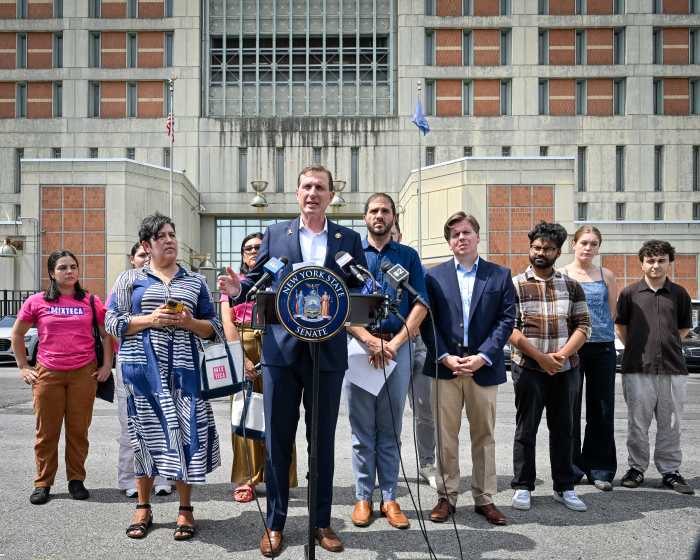By Jessica Mintz
There is a small group of people to whom one could say the word “mangosteen,” and with those three syllables elicit either a swoon, or a sonnet, or both.
These are the facts: The mangosteen (pronounced “mang-uh-steen”) is a tropical fruit, deep beet-purple on its surface, with a thick skin hiding a number of white, fleshy sections inside. Where it hangs from the tree, four leathery leaves grow; on its underside, a starburst in brown, with points varying in number from four to eight.
But the most important bit of information to those who crave it here in New York City is this: A fresh mangosteen is very, very hard to come by. Buying or selling one from the places it grows best is downright illegal.
Why, then, at the sparkling New York Supermarket in Chinatown, nestled under the arch of the Manhattan Bridge on Henry St. between Pike and Market Sts., might one find a single Styrofoam box of mangosteens? Even the workers there, who referred to their small mangosteen bushel as “Thailand fruit” and said they imported it themselves, balked when asked if they knew whether it was legal. One, looking off into the street, quietly said that it was “bu hefa,” Mandarin for “illegal.”
As it turns out, this particular box of mangosteens was frozen solid, and according to Jim Rogers, a spokesperson for the United States Department of Agriculture, frozen mangosteens are exempt from strict import bans blocking their fresh brethren.
Unfortunately, it is the fresh mangosteen that prompts praise (or, in the case of New York Times reporter R. W. Apple Jr., laments heard all the way from Bangkok in a late September article). As David Karp, (a.k.a. The Fruit Detective), a regular writer and photographer of fruit for Gourmet magazine and The Times, said, “frozen is a totally uninteresting topic.”
The mangosteen, which Karp calls the finest of tropical fruits, is in taste and texture “as delicate as the flesh of a perfectly ripe plum, with an exquisite sweet—tart flavor that somehow melded the elegance of temperate fruits and the luxuriance of the tropics.”
Frozen or canned varieties just aren’t the same, say some lovers of the fruit. “A lot of the delicacy of the mangosteen is lost in any of these transmogrifications,” said Karp. He’s come across mangosteen gum, mangosteen shampoo, mangosteen juice – but nothing that really spoke to the eloquent cravings this queen of tropical fruits inspires.
Garcinia Mangostana L., as it is formally known, is grown in places whose climates are hotter and more humid than the southernmost growing areas of Florida – places like Thailand, Malaysia, Burma and Indonesia. Currently, there are no Southeast Asian countries that can legally export mangosteens to the U.S. While mangosteens can come in from some places in the Caribbean and West Indies, like Antigua or Barbuda, according to Karp, those countries just aren’t doing it commercially yet.
There are two federal agencies charged with stopping forbidden fruits at the United States’ borders: the Food and Drug Administration and the United States Department of Agriculture. Their divergent missions translate to two entirely different policies on the import of mangosteens.
The F.D.A., whose goal is to protect public health and ensure the safety of the nation’s food supply, doesn’t even have the mangosteen on its radar.
“There is no information regarding any import alert on this particular commodity,” said Kim Rawlings, a spokesperson for the F.D.A., meaning that it’s not something F.D.A.’s inspectors would be looking out for, much less stop at the border.
The United States Department of Agriculture, on the other hand, protects America’s agriculture, not its humans, from foreign pests and diseases. There is one man in Washington, D.C., who looks closely where the F.D.A. might turn a blind eye.
“Mangosteens are allowed from certain Central American and West Indies places, but not from where it came from originally, in Southeast Asia,” said Dr. Inder Paul Gadh, an agriculturist and import specialist with the U.S.D.A. New fruits are only allowed into the American market “after we have studied the risks involved, and have treatment to mitigate the risks,” Gadh said.
In this case, the risks – fruit flies, maybe, or other noxious pests – are still being investigated. “Certain countries – Thailand being one, Vietnam, other countries – mutually are working on analyzing the pest risks that might come with mangosteen,” said Gadh. “Once we know the risks, we talk with those countries and see how they plan to mitigate the risks.”
Methods used on other fruits have included fumigation and irradiation, both of which Gadh said leave fruit perfectly safe for human consumption. Here, the bottom line is that the Southeast Asian countries where the mangosteen is most easily (and, supposedly, most tastily) grown are a ways off, technically speaking, from being able to export it. At the very least, if it turns out that the mangosteen carries one of just 12 pests known to be effectively wiped out with irradiation, the exporting country would still have to set up an irradiation facility and fund a visit from the U.S.D.A. to make sure everything’s up to snuff.
The cravings of the few in the know, then, drive what Karp thinks is a relatively small black market for fresh mangosteens in New York City. They’re most likely brought into the country from Toronto or Vancouver to feed the needs of sizeable east and west coast Asian communities by people Karp called semiprofessional smugglers.
“There are people who probably smuggle produce in regularly, and they play a serious game with APHIS (the Animal and Plant Health Inspection Service, a branch of the U.S.D.A.,” said Karp.
Once the fruits hit the stalls, it’s up to inspectors working for a New York State agency, the Department of Agriculture and Markets, to ensure that every produce outlet, from corner bodegas to supermarkets, is selling fruit that’s clean, healthy and safe, according to spokesperson Jessica Chittenden. But if no one’s on the lookout for the mangosteen (Chittenden hadn’t heard of them), and there’s no evidence of filth, chances are, it will stay on that shelf.
If an American really wanted to taste a mangosteen, short of heading to Southeast Asia, Karp offered a few recommendations, none terribly cost-effective – try visiting markets in Canada, or in Europe, or better yet, the Hilo farmer’s market just miles from the areas in Hawaii where farmers are experimenting with growing the mangosteen.
If a stroll today through the maze of fruit markets in Chinatown doesn’t yield a fresh mangosteen, there are a few things to keep in mind. First, the tropical growing season has drawn to a close, and waiting until early next summer (and taking the time between now and then to cultivate the friendship of a few produce sellers) might spell success.
Second, and perhaps more in the spirit of the search itself, consider the rambutan an equally compelling prize. Look for something Karp describes best as “bright red fruit with outlandish soft curly spines that [gives] them the appearance of lychees on a bad hair day.” Just recently allowed into the country, its white inner flesh is sugar-sweet and juicy, and worth the trip in its own right.
Reader Services
































